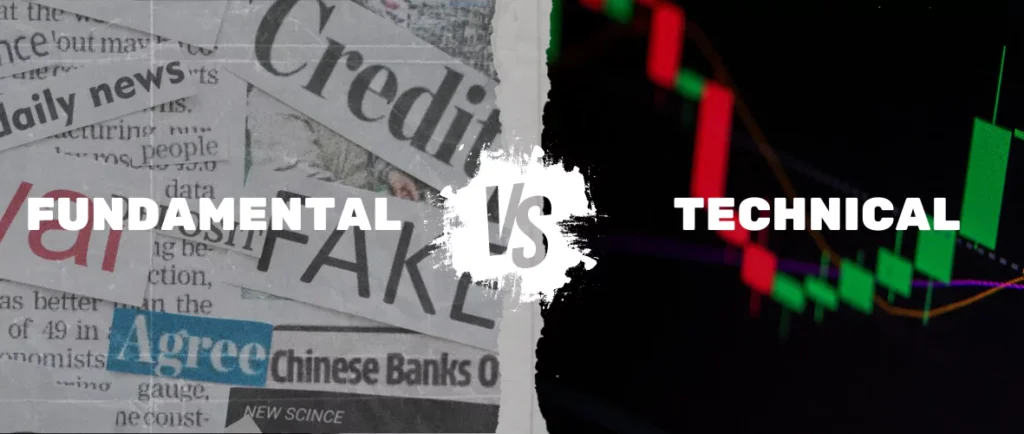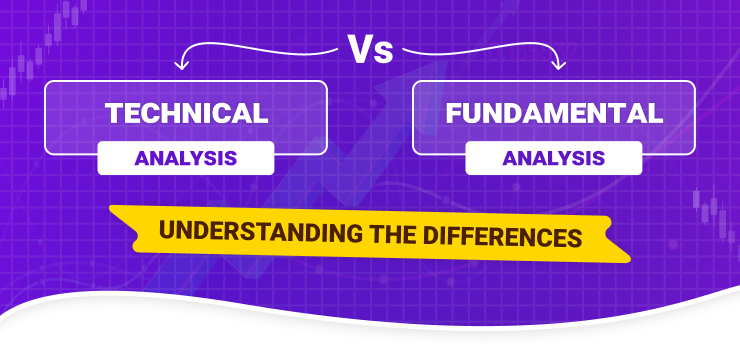When embarking on the journey of learning how to trade currencies or any other financial asset, one of the first key decisions traders face is whether to base their strategy on technical analysis or fundamental analysis. While both technical and fundamental analyses aim to help forecast market movements and high-probability trading opportunities, they take very different approaches.
In this comprehensive guide, we will explore the core philosophies and methodologies behind both technical analysis and fundamental analysis. We’ll outline exactly what each approach entails, provide examples to illustrate key concepts, and highlight the strengths and weaknesses of technical vs fundamental analysis. By the end, readers should have a clear understanding of the distinct nature of these analytical frameworks as well as clarity on when one tends to work better than the other.
What is Technical Analysis?
Technical analysis is a trading methodology that examines historical price charts and volume data to identify trends and trading patterns that may signal future price action. At its core, technical analysis relies on the belief that price patterns repeat themselves due to consistent trader psychology and the tendency for technical indicators like support/resistance levels to influence where traders enter and exit the market.
Some of the key aspects that technical analysts focus on include:
- Price charts: Line graphs, candlestick charts, and bar charts that show open, high, low, and close pricing over time.
- Trends: Identifying upward, downward, or sideways trends by connecting highs/lows with trendlines. Breakouts above resistance suggest further gains.
- Support/resistance: Price zones where buyers/sellers tend to step in, shown by horizontal lines on a chart where prices consolidate before continuing in the prior direction.
- Moving averages: Calculated averages of prior closes (e.g. 50, 100, 200 day MA) that indicate momentum and potential reversal signals when prices cross above/below.
- Indicators: Oscillators like RSI, MACD, and Stochastics that provide additional context on overbought/oversold conditions.
- Patterns: Formations like triangles, flags, pennants, and head and shoulders tops/bottoms that often resolve in predictable directions.
- Volume analysis: Spikes or decreases in volume accompanying price moves that confirm/refute the strength of a trend or breakout.
By assessing these visual cues on charts, technical traders look to predict likely future ranges and identify high-probability entries and exits based on repeating investor behaviors rather than economic or company-specific news flow.
What is Fundamental Analysis?
In contrast to the statistical and chart-based approach of technical analysis, fundamental analysis examines economic, industry, and company-specific factors that influence the intrinsic value and long-term prospects of financial instruments. Some key aspects fundamental analysts cover include:
- Macroeconomics: Broader conditions like GDP growth, inflation, political risks, fiscal/monetary policy, etc. that shape the socioeconomic backdrop.
- Microeconomics: Industry-level dynamics for sectors like expected demand, competitive landscape, input costs, regulation, etc.
- Financials: Income statements, balance sheets, and cash flow statements are carefully scrutinized alongside key metrics like P/E, P/B, and Dividend yield.
- Management: Assessing the competence, strategy, and execution track record of a company’s leadership team.
- Competitive analysis: Benchmarking products/services against peers while considering factors like branding, and scale advantages.
- Valuation modeling: Quantifying the fair value of equities based on DCF, comparable company, and precedent transaction methodologies.
The goal is to analyze qualitative and quantitative fundamentals to identify intrinsically undervalued or overvalued assets by weighing short-term price fluctuations against long-term earnings potential and growth prospects.
Technical vs. Fundamental Analysis: Key Differences

While technical and fundamental analysis both attempt to foresee market behavior, they take starkly opposing perspectives in terms of timeframes, data sources, and underlying philosophies:
Time Horizon: Technical analysis trades over days/weeks based on short-term price momentum, while fundamentals take a longer 3-5-year view based on expected returns.
Input Data: Technicals rely solely on historical price/volume, whereas fundamentals factor in earnings reports, balance sheets, economic indicators, and qualitative judgments.
Causation: Technical analysis attributes market moves to crowd psychology and self-fulfilling technical patterns, not news. Fundamentals root causes in real company/economic changes.
Trading Mechanism: Technicals identify support/resistance breaks and chart patterns, and fundamentals uncover mispriced assets based on an estimated future value.
Strength of Evidence: Technical indicators often lack a theoretical basis and findings are sometimes coincidental, whereas fundamental evaluation rests on accounting principles and financial logic.
Predictive Power: Technical analysis assumes history repeats, but many factors have changed. Fundamentals strive to anticipate changes through research yet cannot foresee black swan events.
As the philosophies stand in contrast, traders must determine where each type of analysis provides the most insightful edge based on their market perspective, preferred time horizon, and strategy. Let’s explore the core strengths of each:
When Technical Analysis Works Best
Technical analysis works effectively when there are chances for quick trades. Shifts in momentum and other patterns that emerge on shorter timescales, such as daily and weekly charts, are often more dependable predictors of upcoming price movement. Finding early indications of trend extensions or reversals may also be accomplished with the use of technical instruments. Profitable trades may be made if traders can identify these movements as they approach recognized levels of support and resistance.
This method is also useful for rules-based systems strategies that depend on stringent technical specifications. Rules-driven models can be developed by algorithmic traders and quantitative funds to profit from recurring technical trends. Technical indicators’ objectivity makes them a good fit for systems-based tactics.
There are other occasions when the market is quite volatile when technical analysis is very useful. During volatile, news-driven market fluctuations, fundamentals could be less informative on the short-term course. Technical levels are still a reliable source of guidance for traders, though.
In comparison to smaller, less liquid names, larger, more liquid stocks, and indexes typically exhibit greater technical trading characteristics. Larger companies’ higher trading volume increases the accuracy of technical setups since volume validates price changes.
Technical analysis also performs well during times when there is a lower risk of unexpected news or macroeconomic events influencing markets. In more quiet periods absent major catalysts, technical factors have increased the potential to drive near-term price behavior. The predictive power of techniques like chart patterns is strongest when volume supports breakouts or holds of identified technical levels.
When Fundamental Analysis Has an Edge

For investing spans of three years or more, fundamental analysis is essential. Price convergence is more likely to occur over long periods when valuation indicators linked to a company’s fundamental strength and earnings potential are used. Technical elements might not be as reliable predictors of long-term trends. In periods of low market volatility and narrow consolidation ranges for equities, fundamental analysis is equally useful since it may provide direction when technical charts become ambiguous.
For smaller-capitalization and less liquid stocks, the predictive power of technical analysis is diminished due to reduced trading activity and price history. However, fundamentals still apply, as intrinsic research into a firm’s financials and operations retains relevance regardless of market size. Another situation where fundamentals exert a clear advantage is around key corporate events such as earnings reports, mergers and acquisitions, or regulatory filings. Company-specific news heavily dictates stock performance surrounding these catalysts.
Performance variations among industries and sectors are more closely linked to distinct underlying business dynamics that are the subject of independent fundamental research. Technical analysis provides a broad perspective, but it is unsuitable to pinpoint winners and steer clear of losers by closely examining the competitive environments, strengths, management styles, and development prospects of specific businesses. Thus, in-depth fundamental research is quite beneficial to active stock pickers. Lastly, investors that use a basic informational advantage have an advantage over less efficient size and foreign markets with unequal information flows.
In summary, the predictive power of fundamental evaluation stands out most notably over longer time frames, less liquid markets with irregular trading, during periods of low price volatility and range-bound consolidations, and when significant company-specific or industry news events strongly influence individual stocks or sectors.
Integrating Technical and Fundamental Analysis
While technical analysis vs. fundamental analysis represent separate schools of thought, in reality, the most pragmatic approach for many traders combines aspects from both frameworks. Key ways to integrate technical and fundamental factors include:
- Use fundamentals to construct watchlists and identify promising investment themes, then monitor technical setups for low-risk entries.
- Cross-check technical breakouts with underlying catalysts or bearish divergence on fundamentals to gauge confirmation.
- Monitor technical levels on fundamentally strong names you own already to add on weakness or tighten stops.
- Incorporate volume, money flow, and sentiment indicators like put/call ratios as technical proxies for institutional demand.
- Factor macroeconomic and industry updates into your technical interpretations of how news may shift chart patterns.
- Pay attention to technical resistance areas that coincide with worrisome changes to company-specific fundamentals.
- Consider topping/bottoming technical formations as flags to reevaluate investment theses and potentially reallocate.
The most consistently successful traders tend to acknowledge the merit in both approaches while also realizing each has limitations that the other complementarily addresses. By layering charts and fundamentals, traders leverage their relative strengths while mitigating individual blindspots.
Conclusion | Technical Analysis vs. Fundamental Analysis
To summarise, there are two appropriate, yet polarizing, frameworks for comprehending market dynamics: technical analysis and fundamental analysis. For a new trader, it is best to concentrate on becoming an expert in both fundamental and technical analysis for several reasons.
Since short-term and day traders work on short timeframes, it is frequently beneficial for them to focus on advanced technical abilities. Long-biased investors, on the other hand, who want to keep holdings for a longer period, should put more value on fundamental research when assessing. Analytical and patient people are probably better at studying financial records, earnings reports, and other basic data. Technical pattern identification and chart reading, on the other hand, can be more appropriate for traders who have intuitive trading approaches and like to trade often.
The particular trading technique used also affects whether a method is more realistic. Technical analysis serves as the main tool for day and swing traders who are dependent on short-term price changes. On the other hand, studying fundamentals is frequently the primary method most useful to passive investors who want to purchase and hold good firms. The state of the market also matters; trending times are better for technical approaches, and range-bound markets are better for fundamental viewpoints.
The most seamless learning process, however, usually involves focusing on one strategy at first and gradually introducing the other over time. In general, traders need to think about their goals, skills, and resources while choosing the best framework.



